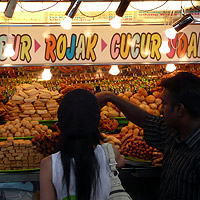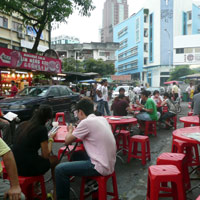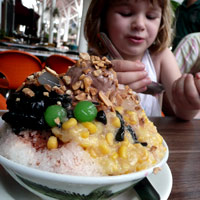|
Malaysian Food
[back to Food Diary Index]
These notes were made during a trip to Malaysia in 2010. These are just our food experiences and you may have a totally different experience depending on your budget, where you travel and where you eat and what you like to eat.
Staples
As in most Asian countries the staples are rice and noodles, and they come either wet or dry (in a soup or stir fried). The difference with Malaysian food is that it is made up if three distinct cuisines; Chinese, Indian and Malay or traditional Nonya style. There is usually a small amount of meat included, and its generally not of the greatest quality. Eggs are also a valuable inclusion in many dishes, either boiled, or stir-fried into a dish.
Influences
The traditional food of Malaysia is the Nonya food, which admittedly we didn't see that much of the traditional style, but there is such influences from the Chinese and Indian immigrants from long ago, that the local foods has been influenced, plus these introduced cuisines have kept to their own so there is such great variety of choices in Malaysia it is hard to get bored of the food. There is also different introduced styles of foods such as restaurants with Japanese, Thai food, Indonesian, and other mostly Asian cultures.
Food Availability
So many amazing foods are available. Starting with the tropical fruits of dragon fruit, star fruit, durian, jackfruit, water melon (yellow and pink), lychees, rambutans, longans, which are all great in their own sweet way. Unfortunately you have to order vegetables separately to your meal, because most mixed dishes, e.g. fried rice or fried noodles do not contain many veggies. There seems to be a limit in variety as well. There are always Asian style greens (bok choy, choy sum, or similar) but not much other variety. Supermarkets stock all the usual stuff, plus some more unusual items (for Westerners anyway).
|
Eating Places
There is such a range of eating places from fancy restaurants to street side stalls, with everything in between. Many of the old style hawkers have been encouraged by local authorities to join together and form a food market place, and there are many of these. This creates a venue with a vast array of choices for the consumer. There is a drinks vendor and sometimes people who take orders for all of them (depending on how large it is) plus staff to clean up tables. It is a great idea, allowing a great, clean atmosphere for the diner, and a busier establishment for the multiple vendors. We ate mostly at these sorts of places, or at mid-level restaurants. We found that the food is not necessarily better at the fancy restaurants, as we tried them a couple of times, and the food was OK, but not matching the higher cost. The street side stalls that have a plate of noodles for 3 RM ($1AU) are often the tastiest! The down side of these venues is the hygiene aspect, and with meat sitting out on plates all day in the hot humid conditions, it can be questionable.
Regional Differences
Because of different histories, there are particular variations and specialties found in some regions of Malaysia. Penang in particular is well know for its exceptional unique foods.
Eating Trends
It is so cheap to eat out in Malaysia it is quite the trend to dine out most of the time and not cook at home. In fact if you were to weigh it up, it may even cost you more to buy all the groceries and cook yourself (so we were told). However there are expensive restaurants, and I suspect you would need to eat at some of the hawkers style eateries for it to be really cheap, which would put the nutritional value of your total intake in question. Many dishes are based on carbohydrate selections, with good to low amounts of protein (depending on your needs), but I feel there is a distinct lack of vegetables in the diet. So I imagine you would or could miss out on vegetables if you solely relied on eating out?
|
Costs
Meals were ranging from 3RM up to 30RM ($1AU - $10AU) depending on the meal. They usually have a selection of small, medium and large sized meals to choose from, which might be 3, 4 and 5RM for some stir fried noodles. A meat based meal like chilli crab would of course be at the higher end of the scale. Also the décor of the restaurant would influence the price. A buffet meal at our fancy hotel was 45RM per person. You could eat a lot, but it wasn't better in quality than other establishments we tried.
Typical Meals
When we travelled in Malaysia, we tended to overeat, as we wanted to choose a few items to try, plus we had to make sure there was something that our kids would like. I believe the tradition is to order a few meals and share them between the group, this is what I witnessed quite a lot when eating out. This is also a Chinese (and Asian) tradition. This is what we would do also. Choosing, one noodle, one rice, some vegetables, or a mixed plate like Nasi Lemak which is rice served with a few different items. The Indian version of this is Nasi Kandar, or Thali.
Many meals are served with soup as a side, which I have worked out is an hydration strategy. As it is so hot in Malaysia many fluids need to be consumed and what better than a salty broth for rehydrating.
|
Drinks
There was a fair selection of drinks available. Freshly squeezed juices are popular, to which they always add sugar syrup, unless requested not to. Juices are always great as they have such a variety of delicious tropical fruits; melons, mango, papaya, dragon fruit, orange, lychee, star fruit, apple, as well as coconut juice from the shell and sugar cane juice. Even carrot was fairly popular in use. Many fruit juices come in cans as well!
-
Soft drinks are also readily available, and often in unusual flavours. Some of the interesting ones were the tropical fruit flavours, green tea, chrysathimum. Even the regular flavours taste different here. Another soft drink was 100Plus, more like a carbonated sports drink which is sweet and contains electrolytes (the amount was not written on the can) and heavily promoted for rehydration due to the hot nature of Malaysia.
-
Milo comes in a can (and box) and is quite popular, because fresh milk is hard to come by.
-
Slushie flavours at a 7-11 were surprising, honey and lemon; which I didn't like but my 3 year old did, cheesecake; which I thought was nice, but not quite like a cheesecake!
-
Coffee is one thing that Malaysians drink a lot of. Because there is a limit to fresh milk, they use sweetened condensed milk, and not a lot of it. Coffee is strong, sweet and not too milky. We got used to it, because this type of coffee is the cheapest. If you want milky coffee you will be served a 3-in-1 (coffee, milk, sugar) sachet to which you simply add hot water. This is the Malaysian style of western coffee, and boy is there loads of different brands of this. As we made our way around KL we realised there is quite an array of Western cafes such as Starbucks, Gloria Jeans, The First Cup, Dome, The Bean Co, and the local version Old Town White Coffee, which provide 'proper coffee' the western way. Cappuccino and real coffee with frothy warm milk. It doesn't come cheap though, with average price for a coffee being 9RM ($3AU) which is what it used to cost in Perth!! Mostly tourists frequent these places. Even milk in the supermarket is labelled fresh milk but is actually UHT milk. Not sure what they used in the Cafes though?
-
Beer is only found in non-Muslim establishments, mainly Chinese and some Indian places. It is not cheap, costing around 11-13 RM (~$4AU) for a large beer, but a little cheaper than at home and cheap enough for us to enjoy one most nights.
|
Eating Utensils
A selection of chopsticks, and fork and spoon are used in Malaysia. A spoon is needed for soups. The traditional Indians still use their hands to eat, which our daughter loved!
Customs
Normally at a restaurant or hawker eatery you would order from the counter, and then take a seat. The custom is to pay for the meal when you receive it, which is great as it saves any confusion about not receiving meals – you just don't pay. Another interesting site was when we stayed at the resort hotel in Batu Ferringi, there were many ladies wearing the burqa, and it was interesting to see how they eat. Some will take the face veil off while eating, whereas others will only pull it up and put the food underneath so as not to expose any skin at all.
Related Pages
Do you have feedback, a comment or correction? Let us know





